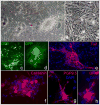Nestin-expressing cells in the gut give rise to enteric neurons and glial cells
- PMID: 22998406
- PMCID: PMC3531577
- DOI: 10.1111/nmo.12015
Nestin-expressing cells in the gut give rise to enteric neurons and glial cells
Abstract
Background: Neuronal stem cells (NSCs) are promising for neurointestinal disease therapy. Although NSCs have been isolated from intestinal musclularis, their presence in mucosa has not been well described. Mucosa-derived NSCs are accessible endoscopically and could be used autologously. Brain-derived Nestin-positive NSCs are important in endogenous repair and plasticity. The aim was to isolate and characterize mucosa-derived NSCs, determine their relationship to Nestin-expressing cells and to demonstrate their capacity to produce neuroglial networks in vitro and in vivo.
Methods: Neurospheres were generated from periventricular brain, colonic muscularis (Musc), and mucosa-submucosa (MSM) of mice expressing green fluorescent protein (GFP) controlled by the Nestin promoter (Nestin-GFP). Neuronal stem cells were also grown as adherent colonies from intestinal mucosal organoids. Their differentiation potential was assessed using immunohistochemistry using glial and neuronal markers. Brain and gut-derived neurospheres were transplanted into explants of chick embryonic aneural hindgut to determine their fate.
Key results: Musc- and MSM-derived neurospheres expressed Nestin and gave rise to cells of neuronal, glial, and mesenchymal lineage. Although Nestin expression in tissue was mostly limited to glia co-labelled with glial fibrillary acid protein (GFAP), neurosphere-derived neurons and glia both expressed Nestin in vitro, suggesting that Nestin+/GFAP+ glial cells may give rise to new neurons. Moreover, following transplantation into aneural colon, brain- and gut-derived NSCs were able to differentiate into neurons.
Conclusions & inferences: Nestin-expressing intestinal NSCs cells give rise to neurospheres, differentiate into neuronal, glial, and mesenchymal lineages in vitro, generate neurons in vivo and can be isolated from mucosa. Further studies are needed for exploring their potential for treating neuropathies.
© 2012 Blackwell Publishing Ltd.
Conflict of interest statement
No competing interests declared
Figures






References
-
- Kiba T. Relationships between the autonomic nervous system, humoral factors and immune functions in the intestine. Digestion. 2006;74(3–4):215–27. - PubMed
-
- Bischoff SC, Mailer R, Pabst O, et al. Role of serotonin in intestinal inflammation: knockout of serotonin reuptake transporter exacerbates 2,4,6-trinitrobenzene sulfonic acid colitis in mice. Am J Physiol Gastrointest Liver Physiol. 2009;296(3):G685–95. - PubMed
-
- Jessen KR, Mirsky R. Glial cells in the enteric nervous system contain glial fibrillary acidic protein. Nature. 1980;286(5774):736–7. - PubMed
MeSH terms
Substances
Grants and funding
LinkOut - more resources
Full Text Sources
Miscellaneous

